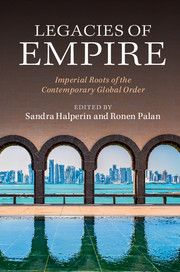Book contents
- Frontmatter
- Contents
- List of figures
- List of tables
- List of contributors
- Acknowledgments
- 1 Introduction: legacies of empire
- Part I Incomplete transitions from empires to nation states
- Part II Legacies of non-European empires in today's world
- 5 The legacy of Eurasian nomadic empires: remnants of the Mongol imperial tradition
- 6 The modern roots of feudal empires: the donatary captaincies and the legacies of the Portuguese Empire in Brazil
- 7 Imperial legacies in the UN Development Programme and the UN development system
- Part III The future legacies of the American Empire
- Index
- References
5 - The legacy of Eurasian nomadic empires: remnants of the Mongol imperial tradition
from Part II - Legacies of non-European empires in today's world
Published online by Cambridge University Press: 05 August 2015
- Frontmatter
- Contents
- List of figures
- List of tables
- List of contributors
- Acknowledgments
- 1 Introduction: legacies of empire
- Part I Incomplete transitions from empires to nation states
- Part II Legacies of non-European empires in today's world
- 5 The legacy of Eurasian nomadic empires: remnants of the Mongol imperial tradition
- 6 The modern roots of feudal empires: the donatary captaincies and the legacies of the Portuguese Empire in Brazil
- 7 Imperial legacies in the UN Development Programme and the UN development system
- Part III The future legacies of the American Empire
- Index
- References
Summary
Introduction: the problem
We should not take for granted that remnants of ‘Western’ imperial tradition are the only ones on display today. It is true that Europe and its settler states dominated the world economically and politically in the nineteenth and twentieth centuries. That does not necessarily mean, however, that the broad European imperial tradition succeeded in eradicating other imperial traditions. There is, furthermore, the possibility that the European tradition was itself indebted to other traditions. In this chapter, we will make the case for the relevance of what we call the Eurasian steppe tradition. We will focus on its lingering importance, and only touch on its historical role as the main other in early European state formation. We first chart the 1,500-year-long history of the steppe tradition and try to capture it by way of an ideal type, and contrast it not with an ideal type of contemporary ‘Western’ polities, but of nineteenth-century-style European empires. The second section is a brief discussion of how the imperial steppe tradition was obfuscated by the European political tradition on the level of discourse. We then trace the continuing importance of the steppe tradition in three areas, namely Central Asia, Turkey and Russia.
A nomadic imperial tradition
Although the pre-history of the imperial steppe tradition in Eurasia stretches back at least to the eighth century BC, and includes some predominantly Iranic-speaking polities, the first documented Eurasian steppe empire, that of the Hsiung-Nu, hails from 209 BC (Di Cosmo 2004).
- Type
- Chapter
- Information
- Legacies of EmpireImperial Roots of the Contemporary Global Order, pp. 99 - 127Publisher: Cambridge University PressPrint publication year: 2015



